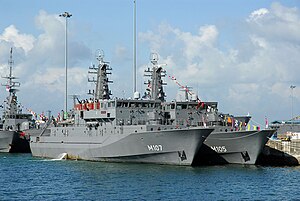
A remotely operated underwater vehicle is a tethered underwater mobile device.

The Republic of Singapore Navy (RSN) is the naval branch of the Singapore Armed Forces (SAF), responsible for the defence of Singapore against sea-borne threats and protection of its sea lines of communications. The service was formally established in 1967 and has since undergone a substantial modernisation.
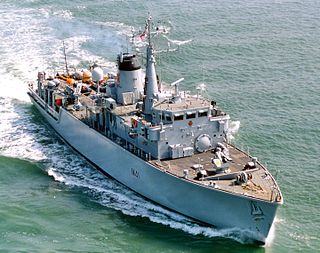
The Hunt class is a class of thirteen mine countermeasure vessels of the Royal Navy. As built, they combined the separate roles of the traditional minesweeper and that of the active minehunter in one hull, but later modifications saw the removal of mine-sweeping equipment. They have a secondary role as offshore patrol vessels.

The Sandown class is a class of fifteen minehunters built primarily for the Royal Navy by Vosper Thornycroft. The Sandown class also serve with the Royal Saudi Navy and the Estonian Navy. The first vessel was commissioned into Royal Navy service on 9 June 1989 and all the British ships are named after coastal towns and cities. They have a secondary role as offshore patrol vessels.
The AN/SQQ-32 minehunting sonar set (MSS) is a variable-depth mine-hunting sonar system originally developed by Raytheon and Thales Underwater Systems for the United States Navy. It includes two separate active sonar systems to detect and classify mine-like objects on the surface, in the volume, or on the bottom of the sea. The sonar systems are packaged in a single towed body tethered to the ship through a cable providing power and data transmission, with the cable length variable via an electric winch. A hole in the ship extending from the sonar maintenance room (SMR) to the hull allows movement of the towed body in different configurations for maintenance, stowage at sea, and minehunting operations. The towed body can be configured for minehunting by either locking to the bottom of the ship's hull for shallow water operations, or by extending and retracting the tow cable to allow for variable depth sonar (VDS) operations. VDS operations are necessary in deep water due to refraction of the sonar from the various temperature layers present in the ocean; with the sonar positioned in the same thermal layer as the suspected mines the error induced by refraction is minimized. The detect and classify sonar subsystems are independently monitored and controlled by two operators at independent panels working together to find and characterize underwater objects as mine or non-mine like objects.
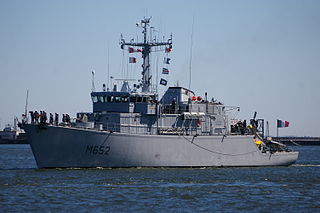
The Tripartite class is a class of minehunters developed from an agreement between the navies of Belgium, France and the Netherlands. A total of 35 ships were constructed for the three navies. The class was constructed in the 1980s–1990s in all three countries, using a mix of minehunting, electrical and propulsion systems from the three member nations. In France, where they are known as the Éridan class they are primarily used as minehunters, but have been used for minesweeping and ammunition transport in Belgium and the Netherlands, where the Tripartites are known as the Alkmaar class.
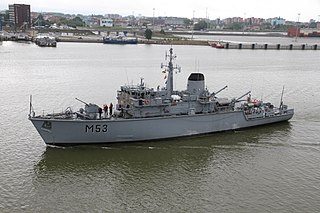
HMS Cottesmore was a Hunt-class mine countermeasures vessel of the British Royal Navy, launched in 1982 and converted in 1997 into a patrol vessel. The ship was declared surplus to requirement and put on the MoD list for disposal in 2004. In 2008 she was bought by Lithuania, along with Dulverton.

HMS Dulverton was a Hunt-class mine countermeasures vessel of the British Royal Navy, launched in 1982 and converted in 1997 into a patrol vessel. The ship was declared surplus to requirement and put on the MoD list for disposal in 2004. In 2008 she was bought by Lithuania, along with Cottesmore.
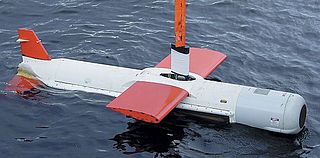
The AQS-20A is a sonar mine countermeasure detection system, developed by Raytheon. The system was initially tested for use on the MH-60S and MH-53E helicopters and as part of the mission package for the littoral combat ships (LCS) and some United States Navy destroyers of the Arleigh Burke class. However, the Chief of Naval Operations excluded the system from use on helicopter assets in March 2012, and only one destroyer has been outfitted with the specific mission package as of April 2009. The AN/AQS-20 naval mine hunting sonar systems will be employed for deeper mine threats. The "Q-20", as it is commonly called, is an underwater towed bodycontaining a high resolution, side-looking, multi-beam sonar system used for minehunting along the ocean bottom. This rapidly deployable system provides real-time sonar images to operators to locate, classify, mark and record mine-like objects and underwater terrain features. The AQS-20 has an active, stabilized underwater vehicle, equipped with advanced multiple-beam side-looking sonar. The underwater body is towed via a small-diameter electromechanical cable, while an operator can view the underwater image and identify objects on a video monitor while recording the data on S-VHS digital tapes for post mission analysis. Operators actually "fly" the device underwater, controlling the depth of the device the same way that an airplane controls its altitude. Once located, the exact coordinates of mine-like objects can be used by explosive ordnance disposal (EOD) personnel to reacquire and neutralize the mine.

Katanpää-class mine countermeasure vessels are a class of three multipurpose mine countermeasure vessels (MCMV) ordered by the Finnish Navy. The nearly 250 million euro contract was awarded to the Italian shipyard Intermarine S.p.A. in 2006. Initially, all three vessels were scheduled to be delivered by 2014 and the class was expected to achieve operational readiness by 2015, but there have been various delays and the last vessel was handed over to the Finnish Navy in November 2016.
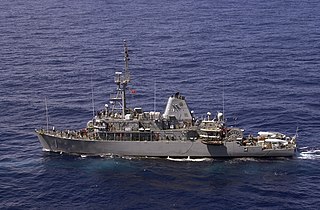
Avenger-class mine countermeasures ships are a class of 14 ships constructed for the United States Navy from 1987 to 1994, designed to clear mines from vital waterways. The ships have the hull designator MCM.

The fourth USS Scout (MCM-8) is an Avenger-class mine countermeasures ship of the United States Navy.

The Bedok-class are mine countermeasures vessels (MCMVs) of the Republic of Singapore Navy (RSN). They play an important role in the maritime security of Singapore, ensuring that the Singapore Strait and the sea lanes surrounding Singapore remain mine-free and open to international shipping. It is estimated that closure of Singapore's ports would result in direct trade losses amounting to more than US$1.2 billion daily, posing a serious threat to Singapore's economy. The four ships form the Sixth Flotilla of the RSN.
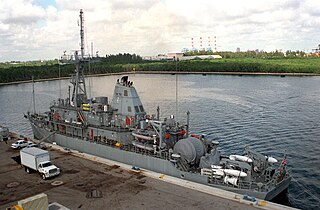
USS Warrior (MCM-10) is an Avenger-class mine countermeasures ship of the United States Navy.

The Lerici class is a class of minehunters constructed by Intermarine SpA and owned and operated by the Italian Navy. The class incorporates two subclasses: the first four ships are referred to specifically as the first series of the Lerici class, while eight more ships produced to a slightly modified design are known as "second series Lericis" or as the Gaeta class.
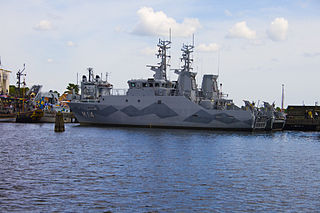
The Styrsö class is a Swedish mine countermeasures vessel built from glass fiber. Among its intended missions are mine detection, mine hunting and patrolling. The ships are named after islands from four different archipelagos of Sweden. In 2004 HMS Spårö and HMS Sturkö were modernised, pulling out some of their capability for traditional mine clearance in favour of extended human dive support, the modified vessels are occasionally called Spårö class.

The Double Eagle is a remotely operated vehicle (ROV) built by the Swedish defence company Saab Underwater Systems AB and used for the disposal of naval mines.

The Koster class is a class of five mine-countermeasure vessels currently in use by the Swedish Navy. Built between 1982 and 1993 as part of the seven-strong Landsort-class mine countermeasures vessels, the last five ships of the class were given a comprehensive midlife upgrade between 2007 and 2010, which resulted in HMS Koster becoming the lead ship of the newly upgraded class of MCMVs. After the upgrade, the Swedish Navy expects that it will serve on for another 15 to 20 years. An identifying feature of the Koster class is the fire control radar on top of the bridge.

The Fleet-class unmanned surface vessel, also called the Common Unmanned Surface Vessel (CUSV) and later the Mine Countermeasures Unmanned Surface Vehicle, is an unmanned surface vessel designed for the United States Navy to be deployed from Freedom and Independence-class littoral combat ships and intended to conduct mine and anti-submarine warfare missions. As of 2012 four units of the class have been built; the first was delivered to the U.S. Navy in 2008.

The Seafox is an anti-mine remotely operated vehicle (ROV) manufactured by German company Atlas Elektronik to locate and destroy ground and moored mines. There are two versions and a training version. The orange Seafox-I "inspection" variant has sonar and an Inertial navigation system, and the black Seafox-C "combat" round has a 1.4 kg shaped charge warhead. The system is in service with eleven Navies across seventy platforms.
